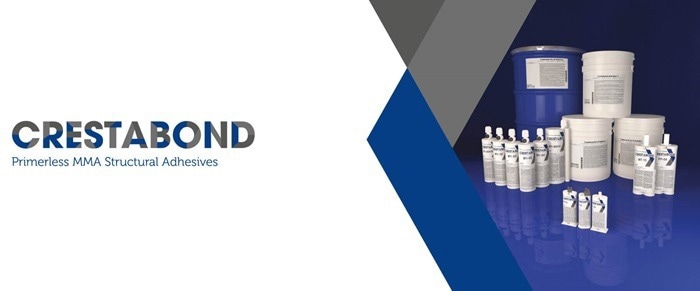Structural adhesives make mechanical fixings like screws and bolts obsolete. These methods for joining typically require an extra production step—drilling a hole—and that hole has the potential to weaken the material or lead to moisture ingress. Using a structural adhesive also has the benefit of saving time from this extra step.

Image Credit: Scott Bader Company Ltd.
Methacrylate Adhesives
Methacrylate adhesives are extremely robust. Scott Bader’s Crestabond range of methacrylate adhesives is formulated for challenging structural use cases that demand high strength.
Scott Bader’s Crestabond range bonds metals, composites, and plastics. A Crestabond product even exists for joining difficult-to-bond, low-surface-energy polyolefins such as polyethylene and polypropylene. Owing to its high degree of flexibility, it can additionally be used to bond dissimilar materials.
Crestabond structural adhesives do not have a primer. This significantly reduces production time, and improves efficiency, allowing users to produce more parts in the same amount of time. It also lessens costs and waste.
Crestabond structural adhesives’ minimal surface preparation saves even more time.
Users can be confident in the finished product’s longevity owing to structural adhesives’ superb fatigue and impact resistance. They are tough and strong.
Crestabond also has a non-sagging option for bonding on vertical surfaces and provides a sandable structural adhesive, meaning any excess can be removed to improve the aesthetic finish.
Urethane Acrylate Adhesives
Scott Bader’s Crestomer structural adhesives have global renown.
Crestomer Urethane Acrylate adhesives can have a similar strength to methacrylate adhesives yet typically have greater elongation and are more flexible. Like methacrylates, they can bond with dissimilar materials.
They are also extremely strong. Like Crestabond methacrylate adhesives, Crestomer urethane acrylate adhesives have superb fatigue and impact resistance and retain their inherent toughness over time.
Crestabond and Crestomer structural adhesives, which are room-temperature cure systems, provide further time and cost savings. This saves on expenses from additional heat, which some other structural adhesives require.
Versatility is another central characteristic. Crestomer structural adhesives are broadly used in the marine industry, but they are also very helpful for customers in land transport, wind energy, building and construction, and the recreational vehicles market. The same is true for Crestabond structural adhesives.

Image Credit: Scott Bader Company Ltd.

This information has been sourced, reviewed and adapted from materials provided by Scott Bader Company Ltd.
For more information on this source, please visit Scott Bader Company Ltd.